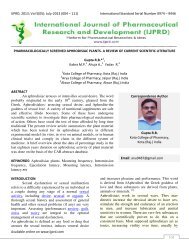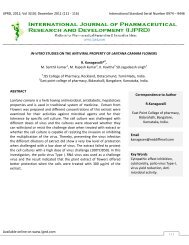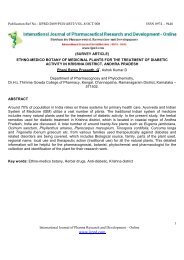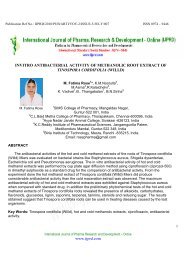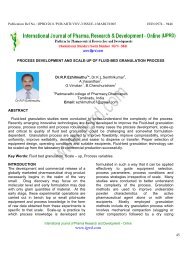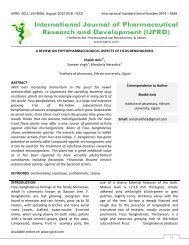Full Text - PDF - IJPRD
Full Text - PDF - IJPRD
Full Text - PDF - IJPRD
Create successful ePaper yourself
Turn your PDF publications into a flip-book with our unique Google optimized e-Paper software.
<strong>IJPRD</strong>, 2013; Vol 5(04): June-2013 (071 – 076) International Standard Serial Number 0974 – 9446<br />
--------------------------------------------------------------------------------------------------------------------------------------------------<br />
ANTIHEPATOTOXIC EFFECT OF“HOLOPETELEA INTEGRIFOLIA (ROXB)”. LEAVES AGAINST PARACETAMOL<br />
INDUCED HEPATIC DAMAGE IN ALBINO RATS<br />
Khushboo Saxena* 1 ,<br />
R.Irchhaiya 1 , Vihangesh Dixit 1<br />
1 Institute Of Pharmacy; Budelkhand University;Jhansi(U.P)<br />
ABSTRACT<br />
The objective of this study was to investigate the hepatoprotective<br />
activity of ethanolic extract of leaves of Holopetlea<br />
integrifolia(Roxb).againt paracetamol induce hepatic damage. There<br />
are lack of reliable hepatoprotective drugs in modern medicine to<br />
prevent and treat paracetamol induce liver damage. The ethanolic<br />
extract showed presence of flavonoid and steroids. The plant material<br />
was dried in shade, powdered and extracted with ethanol. The<br />
hepatoprotective activity of the ethanolic extract was assessed in<br />
paracetamol induced hepatotoxic rats. Biochemical parameters like<br />
SGOT, SGPT, ALP and Bilirubin were tested in drug induced and<br />
untreated groups of rats. Treatment of ethanolic extract of Holopetlea<br />
integrifolia(Roxb).leaves has brought back the altered level of<br />
biochemical parameter to the normal level in the dose dependent<br />
manner and also compared with silymarin used as standard drug.<br />
KEYWORDS : Hepatoprotective, ethanol, leaves.<br />
paracetamol,silymarin.<br />
Correspondence to Author<br />
KHUSHBOO SAXENA<br />
Institute Of Pharmacy; Budelkhand<br />
University;Jhansi(U.P)<br />
Email: Khushbusaxena1987@gmail.com<br />
INTRODUCTION<br />
The liver is one of the most important vital organs<br />
in the human body. Liver plays a significant role not<br />
only in metabolism and detoxification of<br />
exogenous toxins and therapeutic agents, but also<br />
in the bio regulation of fats, carbohydrates, amino<br />
acids, proteins, blood coagulation and<br />
immunomodulation. Many toxins target the liver<br />
and cause hepatotoxic effects that can be observed<br />
through some biochemical parameters.<br />
Impairment of the liver generally occurs from<br />
excessive exposure to xenobiotics, alcohol,<br />
chemotherapeutic agents, virus and protozoan<br />
Available online on www.ijprd.com<br />
infections. Depending upon the severity of toxicant<br />
insult, hepatic cell injury can lead from acute to<br />
chronic hepatitis, which if left untreated can result<br />
in cirrhosis or malignant lesions. Liver damage is<br />
associated with cellular necrosis, increase in tissue<br />
lipid peroxidation and depletion in the tissue GSH<br />
levels. In addition serum levels of many<br />
biochemical markers like SGOT, SGPT, triglycerides,<br />
cholesterol, bilirubin, alkaline phosphatase are<br />
elevated [1] . Liver diseases are the most serious<br />
ailment and are mainly caused by toxic chemicals<br />
(Excess consumption of alcohol, high doses of<br />
paracetamol, carbon tetrachloride,<br />
71
International Journal of Pharmaceutical Research & Development ISSN: 0974 – 9446<br />
chemotherapeutic agents, peroxidised oil,<br />
etc).Plant drugs are known to play a vital role in the<br />
management of liver diseases [2,3] . Holoptelea<br />
integrifolia, the versatile medicinal plant is the<br />
unique source of various types of compounds<br />
having diverse chemical structure a very little work<br />
has been done on the biological activity and<br />
plausible medicinal application of the compounds<br />
and hence extensive investigation is needed to<br />
exploit their therapeutic utilities to combat<br />
diseases. Phytochemical investigation shows the<br />
presence of chemical constituent such as<br />
terpenoids, alkaloids, glycoside, carbohydrates,<br />
steroids, sterols, saponins, tannins, protein, and<br />
flavonoids [5] . The isolated principle are Beta<br />
amyrin, Beta sitosterols, octacosanol, holopettelin-<br />
A, holopetelin-B, hederagenin, hexacosanol, Beta-<br />
D-glucose,fridelin, epifriedelin, 2-amino<br />
napthaqiunone, 1,4-napthalenedione are<br />
considered as responsible for various activity [7] . The<br />
traditional uses, reported<br />
biological/pharmacological activity, isolated<br />
compounds and therapeutic application of<br />
holoptelea integifolia which might be useful for<br />
scientific and researchers to find out new entities<br />
responsible for therapeutic activity.<br />
MATERIAL AND METHOD:<br />
Drugs and Chemicals:<br />
All the chemicals were analytical grade.<br />
Paracetamol was obtained from Amol Pharma<br />
Jaipur (Rajasthan).and silymarin from kypton<br />
pharma.<br />
Plant collection and authentication<br />
The leaves of Holoptelea integrifolia was collected<br />
from Jhansi (U.P), and Identified and authenticated<br />
by National vrkshayurveda research institute<br />
Jhansi. The accession no. is NVRI/05551/2011. The<br />
leaves was dried in shade, and finally grounded in<br />
powdered form in and electronic grinder and<br />
stored in cellophane bags at 4 o C until use.<br />
Preparation of Extract:<br />
The air dried and coarsely powdered leaves (350 g)<br />
were first extracted with 1ltr petroleum ether<br />
about 40-80 o C to remove all fatty acids and again it<br />
is extracted with ethanol (95%) in a soxhlet<br />
Available online on www.ijprd.com<br />
apparatus for 70 hr .The extract were concentrated<br />
to dryness under reduced pressure and controlled<br />
temperature (30-50 o C).The yield value of both the<br />
leaves extract is recorded.<br />
Animals:<br />
Healthy Wistar-albino rats weighing about (180-<br />
250gm) of either sex were obtained from animal<br />
house, Institute of Pharmacy, Bundelkhand<br />
University, Jhansi. The animals were housed in<br />
specific standard laboratory conditions. The<br />
conditions were kept in a temperature-controlled<br />
environment (25±1 0 C) and with a regular 12h<br />
light/12h dark cycle. All animals were fed with<br />
commercial diet & water ad libitum, during the<br />
experiment. All protocols of the study was<br />
approved by the Institutional Animal Ethical<br />
Committee with reference no.<br />
BU/Pharm/IAEC/11/022.The IAEC is approved by<br />
Committee for the Purpose of Control and<br />
Supervision of Experiments on Animals (CPCSEA)<br />
with registration no. 716/02/a/CPCSEA Dose and<br />
Treatments: Rats were divided into different<br />
groups (n=6). Silymarin syrup (0.5ml/100gm),<br />
Paracetamol (2gm/kg) & HIEE (200 and 400 mg/kg)<br />
were administered orally. The control group<br />
received 1.5% Tween 80 in distilled water as<br />
vehicle (10ml/kg B.W.).<br />
Experimental Design: The general principle<br />
involved in the evaluation of Hepatoprotective<br />
activity is to induce liver toxicity or infection with<br />
the help of hepatotoxin in the liver of experimental<br />
animals. The magnitude of the protective activity is<br />
measured in-vivo by estimating the following<br />
parameters:<br />
Biochemical Parameters: These are the most<br />
reliable parameter in the in-vivo study & include<br />
the estimation of different enzyme like SGOT or<br />
Aspartate transferase & Alanine transferase or<br />
SGPT & Serum alkaline phosphate (SALP). It also<br />
includes estimation serum bilirubin (SBLN) &<br />
estimation of Hydroxyproline fat & protein content<br />
of Livers.<br />
Groups of Animals: The animals were divided into<br />
five groups of six animals each.<br />
72
International Journal of Pharmaceutical Research & Development<br />
ISSN: 0974 – 9446<br />
• Group І: served as control & received 1.5%<br />
Tween 80 in distilled water as vehicle (10ml/kg<br />
• Group IV: received HIEE (200mg/kg/day)<br />
simultaneously 7 days followed by Hepatotoxin.<br />
B.W.) for 7 days.<br />
• Group V: received HIEE (400mg/kg/day)<br />
• Group II: received vehicle for 7 days followed<br />
by Hepatotoxin (2gm/kg B.W.).<br />
simultaneously Hepatotoxin. [11]<br />
7 days followed by<br />
• GroupIII: received silymarin (0.5ml/100gm B.W.<br />
per day) simultaneously 7 days followed by<br />
Hepatotoxin.<br />
Paracetamol was administered to animals of<br />
Groups II, III, IV & V in single dose (2gm/day B.W.)<br />
as suspension of 1.5% tween 80.<br />
Table1:Effect of Holopetlea integrifolia. Extract on Biochemical Parameters in Rats Subjected to Paracetamol<br />
Induced Hepatotoxicity.<br />
Enzyme group<br />
SGOT<br />
SGPT<br />
SALP<br />
Bilirubin<br />
Control group 25.30±0.089 27.5524±0.085 89.217±1.5 0.78±0.06<br />
PCM treated group 67.28±1.25 42.350±0.150 2414.25±26.03 1.875±0.006<br />
Standard group 56.20±0.103 34.383±0.160 1456.20±0.839 1.317±0.006<br />
HIEE(200mg/kg B.W.) 44.283±1.22 30.283±0.054 424.100±0.052 1.11±1.696<br />
HIEE(400mg/kg B.W). 29.183.40±0.060 21.383±0.145 116.217±0.122 1.157±0.011<br />
Statistical Analysis The results were expressed as<br />
mean ± SEM of six animals from each group. The<br />
statistical analysis were carried out by one way<br />
analysis of variance (ANOVA) P values < 0.05 were<br />
solution for histopathological study. The pieces of<br />
liver were processed and<br />
embedded in paraffin wax sections were made<br />
about 4-6μm in thickness. They were stained with<br />
considered significant.<br />
Histopathological Examination: Small pieces of<br />
liver tissue were collected in 10% formaldehyde<br />
hematoxylin and photographed.<br />
Photograph:1,2 Liver of rat treated with vehicle, Liver of rat treated with paracetamol.<br />
Photograph :3 Liver of rat treated with syrup silymarin.<br />
Available online on www.ijprd.com<br />
73
International Journal of Pharmaceutical Research & Development<br />
ISSN: 0974 – 9446<br />
Photograph: 4 Liver of rat treated with HIEE (200mg/kg bodyweight)<br />
Photograph 5: Liver of rat treated with HIEE (400mg/kg bodyweight)<br />
RESULT AND DISCUSSION:<br />
The present work was to carried out with the<br />
objective of ethanolic extract of leaves of<br />
marker of the extent & type of hepatocellular<br />
damage [6] . The mode of action of paracetamol on<br />
the liver is by covalent binding of its metabolite, n-<br />
Holopetlea integrifolia(Roxb.). Phytochemical acetyl-p-benzoquinone-amine amine to sulfhydryl group<br />
investigation, evaluation of the Hepatoprotective of protein resulting in cell necrosis and lipid<br />
activity (in-vivo) against PCM induced peroxidation [7] . Due to liver injury caused by PCM<br />
Hepatotoxicity model.Liver is a versatile organ in overdose, the transport function of the<br />
the body concerned with regulation of internal<br />
chemical environment. Therefore damage to the<br />
liver inflicted by a hepatotoxic agent is of grave<br />
consequence. In the present study, the ethanolic<br />
extract of Holopetlea integrifolia(Roxb.). was<br />
observed to exhibit hepatoprotective effect as<br />
demonstrated by a significant decrease in SGOT,<br />
SGPT and SALP concentration, and preventing liver<br />
hepatocytes gets disturbed resulting in the leakage<br />
of plasma membrane [8] thus causing an increase in<br />
serum enzyme levels. Assay of the activities of<br />
these serum marker enzymes and HIEE helps to<br />
assess the liver function [9] .<br />
Herbal Silymarin is a unique, all natural, complex<br />
multi-ingredient formula. It helps in protecting the<br />
liver from harmful toxins & regulates levels of<br />
histopathological changes in rats induced with PCM enzymes and optimizes assimilation. Herbal<br />
hepatotoxicity. Paracetamol is a well known<br />
antipyretic & analgesic agent, which is safe in<br />
therapeutic doses but can produce fatal necrosis in<br />
experimental animals & humans & is employed as<br />
an experimental hepatotoxic agent. A sign of<br />
hepatic injury is the leaking of cellular enzymes into<br />
the plasma due to the disturbances caused in the<br />
transport functions of hepatocytes. The estimation<br />
Silymarin has been found to be associated with an<br />
increase in serum albumin & restores the<br />
functional efficiency of the liver by promoting the<br />
hepatocellular regeneration. Silymarin is believed<br />
to be the first multi-herb remedy granted<br />
regulatory approval as a drug, Silymarin, the well<br />
known hepatoprotective product. Silymarin is a<br />
favoured drug for different liver diseases because<br />
of enzymes in the serum is a useful quantitative<br />
Available online on www.ijprd.com<br />
74
International Journal of Pharmaceutical Research & Development ISSN: 0974 – 9446<br />
of its oral effectiveness, good safety profile,<br />
avaialvility in India and importantly affordable [10].<br />
In this experiment, it is observed that the level of<br />
hepatic biochemical markers i.e. SGOT, SGPT, SALP<br />
& Bilirubin is increased due to PCM in comparison<br />
to the control group. This clearly indicates that<br />
there is significant hepatic damage due to the<br />
paracetamol. The toxic effect of PCM was<br />
controlled in animals treated with ethanolic extract<br />
of Holopetlea integrifolia. 400 mg/kg/day by way of<br />
restoration of the markers levels in the liver with<br />
comparison to positive control Silymarin.<br />
Hepatoprotective effect of HIEE was further<br />
confirmed by histopathological studies of the liver,<br />
which basically supported the results from the<br />
serum assay. HIEE administration resulted in<br />
bringing about an almost normal histological<br />
architecture of the liver. The preliminary<br />
phytochemical screening of Holopetlea integrifolia<br />
leaves shows the presence of flavonoids and<br />
Steroids compounds as major active principle in<br />
ethanolic extract of H.integrifolia. leaves. Many of<br />
flavonoids and steroids(Beta- steroid) compounds<br />
have been reported for hepatoprotective activity.<br />
ACKNOWLEDGEMENT<br />
The authors are grateful to Dr.R,Irchhaiya Head of<br />
the department of pharmacy and Mr.Vihangesh<br />
Dixit, Assistant professor, Bundelkhand university<br />
Jhansi(U.P).<br />
REFERENCES<br />
1. Handa SS, Sharma A, Chakraborty KK. Natural<br />
products and plants as liver protecting drugs.<br />
Fitoterapia 1989; 57: 307-51.<br />
2. Hikino H, Kiso Y. Natural products for liver<br />
diseases in Economic and medicinal plant<br />
research. Vol 2, Academic press, London.<br />
1988:39-72.<br />
3. Evans WC. An overview of drugs having<br />
anithepatotoxic and oral hypoglycaemic<br />
activities In: Trease and Evans pharmacognsoy,<br />
14 th ed. U.K., W.D. Sanders Company Ltd. 1996.<br />
4. Sharma A, Shing RT, Sehgal V, Handa SS,<br />
Antihepatotoxic activity of some plants used in<br />
Available online on www.ijprd.com<br />
herbal formulations. Fitoterapia 1991; 62: 131-<br />
8<br />
5. Mahmud S, Shareef H, Ahmad M, Gouhar S,<br />
Rizwani GH.Pharmacognostic studies on fresh<br />
mature leaves of Holoptelea Integrifolia (Roxb.)<br />
Planch. Pakistan Journal of botany<br />
2010:42(6);3705-3708<br />
6. Sabir SM, Rocha JBT: Water extractable<br />
phytochemicals from Phytollanthus niruri<br />
exhibit distinct in-vitro antioxidant & in-vivo<br />
hepatoprotective activity against PCM induced<br />
liver damage in mice. Food Chemistry 2008; 11:<br />
845-851.<br />
7. Sabir SM, Rocha JBT: Water extractable<br />
phytochemicals from Phytollanthus niruri<br />
exhibit distinct in-vitro antioxidant & in-vivo<br />
hepatoprotective activity against PCM induced<br />
liver damage in mice. Food Chemistry 2008; 11:<br />
845-851.<br />
8. Zimmerman HJ, Seeff LB: Enzymes in the<br />
hepatic disease. In: Goodly, E.I (Ed.), Diagnostic<br />
Enzymology. Lea and Febiger, Philadelphia.<br />
USA. 1970; 1.<br />
9. Sreedevi CD, Latha PG, Ancy P, Suja SR, Shyamal<br />
S, Shine VJ, Sini S, Anuja GI, Rajasekharan S:<br />
Hepatoprotective studies on Sida acuta Burm.<br />
F. J Ethnopharmacol 2009; 124: 171-175.<br />
10. Pradhan S.C,Grish .C ;Hepatoprotective herbal<br />
drug,Silymarin from Experimental<br />
pharmacology to clinical medicine: Indian<br />
Journal of Med Res 124, November<br />
2006,pp491-504.<br />
11. Wadekar Raju Ratan, Supale Radhika Sachin,<br />
Tewari, Kunal Mahesh, Patil Kalpana S,<br />
Jalalpure Sunil Satyappa: Screening of roots of<br />
Baliospermum montanum for hepatoprotective<br />
activity against paracetamol induced liver<br />
damage in albino rats. International Journal of<br />
Green Pharmacy 2008; 220-223. Bambhole VD<br />
and Jiddewar GG. Antiobesity effect of iris versicolor<br />
and holoptelea integrifolia in rats.sachitra Ayurveda<br />
1985;37:557-561<br />
12. Rajbhandari M, Wegner U, julich M, Schopke T and<br />
Mentel R screening of Nepalese medicinal plants for<br />
antiviral activity journal of<br />
Ethanopharmacology2001;74:251-255<br />
75
International Journal of Pharmaceutical Research & Development ISSN: 0974 – 9446<br />
13. Sharma S, khathri P, Samanta KC, Sharma A, Pandey<br />
A, Jakhetia V, Aggarwal P. phyto-pharmacognostic<br />
study of holoptelea integrifolia Roxb. Journal of<br />
global pharma technology2010;2(10); 53-61<br />
14. Mahmud S, Shareef H, Ahmad M, Gouhar S, Rizwani<br />
GH.Pharmacognostic studies on fresh mature leaves<br />
of Holoptelea Integrifolia (Roxb.) Planch. Pakistan<br />
Journal of botany 2010:42(6);3705-3708<br />
15. Sandhar HK, Kaur M, Tiwari P, Salhan M, Sharma P,<br />
Prasher S, kumar B. Chemistry and medicinal<br />
properties of Holoptelea integrifolia.International<br />
journal of drug development and research<br />
2011;3(1);06-11<br />
16. Sharma S, Lakshmi K.S, Patidar A, Chaudhary A,<br />
Dhakar S, studies on anti- inflammatory effect of<br />
aqueous extract of leaves of Holoptelea integrifolia,<br />
planch in rats . Indian Journal of Pharmacology<br />
2009;41 (2); 87-88.<br />
17. Sharma S, Lakshmi KS, and Rajesh T. Evaluation of<br />
Antidiarrhoeal potentials of ethanolic extracts of<br />
leaves of Holoptelea integrifolia in mice model .<br />
International Journal of pharmaTec research<br />
2009;(3);832-836<br />
18. George SK, Rajesh R, S kumar S, Sulekha B, Balram<br />
P. polyherbal ayurvedic drug –indukantha ghritha as<br />
an adjuvant to cancer chemotherapy via immune<br />
omodulation Immunobiology 2008;213;641-649<br />
19. Lakshmi KS, Shrinivas S, Rajesh T, and Chitra V.<br />
antitumor activity of ethanolic extract of leaves of<br />
holoptelea integrifolia on Dalton’s ascetic<br />
lyumphoma in swiss albino mice.International<br />
journal of green pharmacy 2010;44-47.<br />
20. Puri S, Dednath J, Tiwari P, Salhan M, Kaur M,<br />
Mittan A. Camparative pharmacological evaluation<br />
of adaptogenic activity of Holoptelea integrifolia<br />
and withania somnifera.International journal of<br />
drug development and research 2011;3(1);84-98<br />
21. Saraswathy A, Devi SN, Ramasay D.Antioxidant<br />
,heavy metals and elemental analysis of holoptelea<br />
integrifolia planch. Indian journal of pharm science<br />
2008;70(5);676-683.<br />
22. Srinivas RB, Kiran KKR, Naidu VG, Madhusudhana K,<br />
Agwane SB, Ramkrishna S, Diwan PV. Evaluation of<br />
antimicrobial, antioxidant and wound healing<br />
potentials of holoptelea integrifolia. Journal of<br />
ethanpharmacology 2008; 115(2):249-56.<br />
23. Durga N, and paarakh PM.Evaluation of<br />
anthelmintic activity of stem bark of holoptelea<br />
Available online on www.ijprd.com<br />
*****<br />
integrifolia (roxb.) planch .International journal of<br />
research in Ayurveda and pharmacy 2010;1(2):637-<br />
641<br />
24. Kaur S,Kumar B, Puri S, Tiwari P, Divakar K<br />
.camparative study of anthelmintic activity of<br />
aqueaous and ethanolic extract of bark of<br />
holoptelea integrifolia.International journal of drug<br />
development and research 2010;2(4):758-763.<br />
25. Sharma S, Khatri P, Pandey A, Jakhetia V, Chaturvedi<br />
L, Diwedi N. Antidiabetic screening of leaves extract<br />
of Holoptelea integrifolia Roxb. International<br />
journal of pharma.Research and<br />
Development.2010;2(10):66-71<br />
26. Vinod NV, Shijina R, dileep KV, sadadsivan C.<br />
Inhibition of beta –lactamase by 1,4-<br />
naphthalenedione from the plant Holoptelea<br />
integrifolia.Applied Biochemistry 2010;160:1752-<br />
1759.<br />
27. Kumar D, Kumar K, Gupta J, Bishnoi of tropical<br />
Biomedicine2011;1-6N, Kumar S.A review on<br />
chemistryand Biology Of Holoptelea integrifolia.Asia<br />
pacific Journal<br />
28. Acharaya D. Monkey’s favourite seasonal fruit:<br />
Holoptelea integrifolia. Americal chronicle.2008;1-5<br />
29. Khare CP,Encylopedia of India medicinal plants,<br />
springer,2004;p.251-252<br />
30. Prajapati,P, Patel,NM . pharmacognostic and<br />
phytochemical evaluation of leaves of Holoptelea<br />
Integrifolia . International journal of pharmaceutical<br />
science 2010;1:34-40<br />
31. Kirtikar , K.R, Basu, B.D; Indian medicinal plants.<br />
Bishen singh and Mahendrapal singh<br />
publisher,dehradun, India,1999.<br />
32. Bhutani,KK, Gohil, VM .Natural products drug<br />
discovery in India. Status and appraisal.Indian<br />
journal of experimental biology2010;48:199-207<br />
33. Pulliah T.Encyclopedia of world medicinal plants.<br />
Regency publication. 2006;3.p.1095-1097.<br />
34. Mudgal V and Pal DC. Medicinal plants used by<br />
tribal (Orissa) bulletin of Botany<br />
survindia1980;22:59-62<br />
35. Maheswari JK and singh H. Herbal remedies of<br />
Nainital district, U.P Aryavaidyan 1990;4:30-34<br />
36. Mulla WA, thorat VS, patil RV, Burade KB.<br />
Anthelmintic activity of leaves of Alocasia indica<br />
Linn. International journal of pharmaTech research<br />
2010;2(1):26-30.<br />
76



